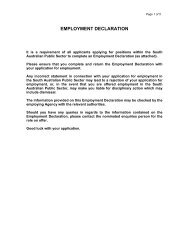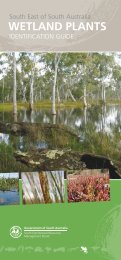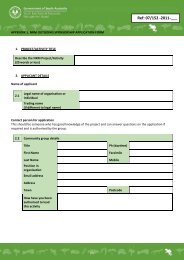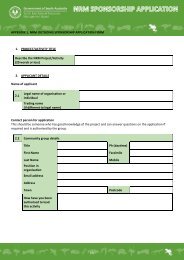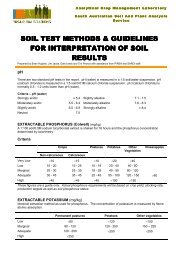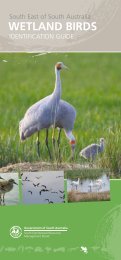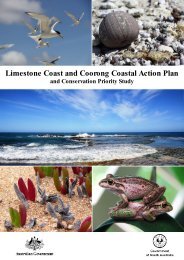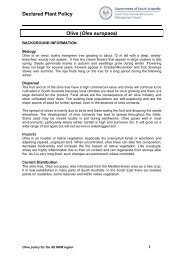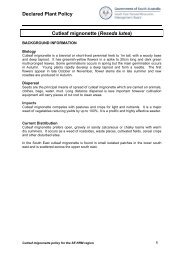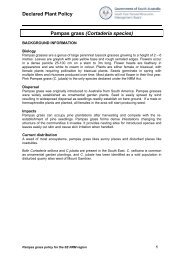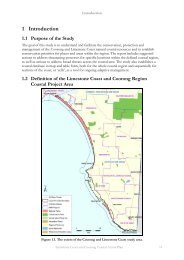Cell Descriptions - South East Natural Resources Management Board
Cell Descriptions - South East Natural Resources Management Board
Cell Descriptions - South East Natural Resources Management Board
You also want an ePaper? Increase the reach of your titles
YUMPU automatically turns print PDFs into web optimized ePapers that Google loves.
SE13 – Kingston SE<br />
and preliminary discussions have been held involving DENR and SEWCDB staff (Slater and<br />
Farrington 2010).<br />
Conservation Analysis (GIS)<br />
106.54, the sum of conservation means, is low for this region.<br />
Priority based on numbers of threatened plant species is high and although moderate totals are<br />
seen for species richness, numbers of threatened bird species, numbers of threatened reptile<br />
species and viewscape, no other conservation layer totals stand out.<br />
Nevertheless, within the cell the pattern of high and low conservation totals is complex, with the<br />
small wetlands within and behind the low sand dune ridges showing high totals adjacent to very<br />
low totals: the high value areas being due to reptile and focal species habitat: Swamp Skink and<br />
<strong>South</strong>ern Bell Frog. Wetlands at Hog Lake and SE towards the Cape Jaffa marina show high<br />
values; wetlands of the Butchers Gap CP show medium high values. The northern end of Maria<br />
Swamp wetland has been included as an extension of the boundary because of its coast adapted<br />
plant species; it shares many high conservation values with a number of inter-dunal wetlands in<br />
the west and south of the cell, including threatened fauna habitat, notably the <strong>South</strong>ern Bell Frog<br />
and the Swamp Skink. These areas stand out because of their high conservation value totals.<br />
The dunes and sand ridges within 600m of the shore, from Wyomi Beach for some 12km to the<br />
SE show medium to medium high values; further inland the dunes have been cleared and give<br />
low conservation totals.<br />
Threat Analysis (GIS)<br />
73.60 is the second largest total of threat summary means within the SE region.<br />
Several variables contribute to the large threat total: off road vehicle damage, development<br />
zoning, land ownership, viewshed, viewscape, existing development, land use, vegetation block<br />
degradation, the distribution of significant weeds, as well as numbers of rabbits. ORV tracks are<br />
found widely across the cell and the concentration along the dunes and sand ridges of northern<br />
parts of Butchers Gap CP is notable. Development zoning gives the potential for loss of<br />
significant reptile habitat on the eastern edge of the marina development. While zoning preserves<br />
the coastal strip, most conservation values are in the landward edge of the coastal zone, in the<br />
small wetlands zoned for primary industry. Butchers Gap CP and areas north within the cell are<br />
threatened by SE Petroleum Production licenses.<br />
All parts of the cell give high threat totals: no areas of low threat total are found on the combined<br />
map, only Butchers Gap CP shows a substantial area of medium to high threat.<br />
Adaptation to Climate Change: Threats for cell SE13<br />
(see also discussion of scenario in Section 4.11<br />
NOTE: the advice below is indicative of likely change and the direction of change, with<br />
implications for ecosystems. Dates, amounts and probabilities cannot be accurately calculated at<br />
this time. Thus advice on flood levels, for example, should not be used in engineering or<br />
development planning.<br />
Climate change<br />
element/ scenario<br />
Combined climate<br />
changes and sea<br />
level rise<br />
Impacts and implications Protect and manage Address landscape<br />
(for this cell) habitat threats issues: fire,<br />
connectivity,<br />
refuges, hydrology<br />
This cell presents a complex<br />
pattern of habitats sensitive<br />
to change.<br />
Create a baseline for<br />
shoreline, dune and lake<br />
change by establishing a<br />
Limestone Coast and Coorong Coastal Action Plan 429



